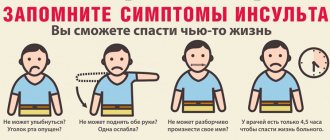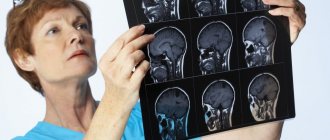Adamenko R.Ya.. Sidelkovsky A.L., Fedorets V.G.
National Medical Academy of Postgraduate Education named after P.L. Shupik
Family doctor clinic "Rusanovka"
It is known that cerebrovascular diseases are one of the most important problems of modern neurology. The number of vascular diseases of the brain is constantly growing throughout the world, which is associated with the aging of the planet’s population and an increase in the number of risk factors: arterial hypertension, atherosclerosis, diabetes mellitus, dyslipidemia, etc. our knowledge about the importance of risk factors in the occurrence of vascular accidents is incomplete.
Ukraine, unfortunately, ranks 1st in Europe in terms of mortality from cardiovascular diseases. 130,000 - 140,000 strokes and 48,000 myocardial infarctions are recorded annually. Up to 20% of patients die in the first month after a stroke. 60% of stroke survivors are disabled with profound impairment of brain function, and only 20% of patients return to work. These statistics dictate the need to find optimal treatment options for chronic vascular insufficiency, which ultimately leads to strokes.
According to WHO, mortality from coronary heart disease was 379 cases per 100 thousand of the world's population, from vascular diseases of the brain - 289, from malignant neoplasms - 200. These are the average data of world statistics. But in most economically developed countries over the past 10-15 years there has been a significant decrease in morbidity and mortality, the cause of which is a disruption in the functioning of the cardiovascular system. This is due, first of all, to the state’s concern for the health of the nation, to the formation of a healthy lifestyle for citizens, the nature of their diet, and the fight against the most important risk factors for the development of heart attack and stroke.
Chronic cerebral circulatory failure and vascular encephalopathy have their own stages of development. In the initial stages of the disease, patients report headache, dizziness, and decreased performance only after excessive and unusual emotional and physical stress. During this period, they show signs of asthenia and attention disorders. As a rule, there are no signs of organic brain damage.
As the disease progresses, patients note an increase in attacks of headaches, dizziness, noise in the head, decreased memory and performance, which do not significantly depend on the nature of the work performed. The neurological status reveals significant cognitive impairment, insufficiency of the function of individual cranial nerves, movement disorders, sensory impairment and coordination disorders.
Subsequently, the symptoms of predominant damage to one or another vascular system of the brain are more clearly defined, and pseudobulbar disorders appear.
One of the most common types of chronic brain failure is vertebrobasilar insufficiency (VBI). The cause of VBI can be not only atherosclerotic stenosis of the vertebral arteries, but also their deformation, congenital hypoplasia of one of the vertebral arteries, compression of one of the vertebral arteries, compression of the vertebral artery halfway through the bone canal, etc. VBN is characterized by: frequent attacks of dizziness, which are accompanied by nausea and sometimes vomiting; unsteadiness when walking; occipital headaches; hearing loss, tinnitus; decreased memory for current events; attacks of “foggy” vision, the appearance of “spots”, “zagzags” in the field of vision; attacks of sudden falling, usually without loss of consciousness (“drop attacks”), incoordination.
When the carotid system is damaged, pyramidal insufficiency, sensory impairment, and a progressive increase in cognitive impairment (decreased memory, attention, intelligence) are noted, which reach the level of dementia in the last stages. Dementia can be described as a combination of severe cognitive impairment, personality changes with significant difficulty in normal social activities and the inability to continue working.
Quite often, with discirculatory encephalopathy, a syndrome such as vascular parkinsonism occurs, which is manifested by steadily increasing stiffness, trembling of the limbs, and slowing of movements. A common symptom of dyscirculatory encephalopathy is emotional and personal changes. Often there is a decrease in mood (depression), fatigue and decreased performance (asthenia), tearfulness, irritability, and insomnia. Negative character traits may worsen: anger, intolerance, etc.
The pathogenesis of dyscirculatory encephalopathy (DE) is caused by cerebral circulatory failure, which can be either chronic (due to atherosclerotic or diabetic damage to the vascular wall, arterial hypertension, venous stagnation, changes in the rheological properties of blood, cardiac or pulmonary failure, etc.), or caused by repeated acute episodes of dyscirculation. A significant role in the pathogenesis of DE is played by the state of the blood system: impaired microcirculation, which is caused by increased platelet activity, blood viscosity, hemoconcentration, chronic disseminated intravascular coagulation. The main links in the cascade are glutamate “excitotoxicity” with activation of intracellular enzymes, accumulation of intracellular Ca2+, increased synthesis of nitric oxide and oxidative stress, development of a local inflammatory reaction, damage to the blood-brain barrier and microcirculatory disorders. At the same time, it was revealed that, despite the presence of universal patterns, the process of cerebral ischemia is largely individual, and the features of its course are determined by the background state of brain metabolism, the status and reactivity of the neuroimmunoendocrine system.
The tactical actions of a doctor in the treatment of CNM are based on knowledge of the patient’s risk factors, the pathogenesis of cerebral ischemia, which serves as a trigger for the development of the “ischemic cascade” of neurometabolic, neurotransmitter, neurotrophic reactions that form an individual profile of clinical symptoms.
To diagnose chronic vascular pathology of the brain, the following is necessary: a general clinical examination of the patient with mandatory measurement of blood pressure and auscultation of the main arteries of the head and neck; examination of neurological status; psychodiagnostic research; bichemical blood test with determination of dipid profile, coagulogram, hematocrit, glucose, etc.; ophthalmoscopy; electrocardiography; clinical and instrumental examination (rheoencephalography, electroencephalography, Doppler ultrasound of intra- and extracranial vessels); methods of objective neuroimaging (computer and magnetic resonance imaging).
In the structure of risk factors for morbidity and mortality from stroke, arterial hypertension ranks first.
Hypertension is the most common non-communicable disease in the world. It not only makes up a significant part in the structure of diseases of the cardiovascular system, but is also a factor that contributes to the development and progression of atherosclerosis, coronary heart disease, and acute cerebrovascular accident.
Isolated systolic hypertension (HTN) in elderly patients is associated with a 2- to 4-fold increase in the incidence of stroke compared with age-matched normotensive patients. According to a study conducted in Gothenburg, older people with hypertension are more likely than normotensive people to develop moderate cerebrovascular disorders (so-called cerebrovascular insufficiency), which can subsequently lead to brain atrophy.
Risk factors for hypertension:
- reversible (tobacco smoking, nutritional factors, excess body weight, psychosocial status, physical inactivity, etc.);
- irreversible (gender, race, age, heredity).
61% of patients are treated with antihypertensive drugs. The effectiveness of treatment is 20.9%. Among patients receiving antihypertensive therapy, almost half of stroke cases are associated with poor blood pressure control, especially in people over 70 years of age.
The benefits of lowering blood pressure for the prevention of cerebrovascular complications are not limited to severe and moderate hypertension. The prognosis also improves with the treatment of mild and borderline hypertension and the reduction of high normal blood pressure.
In past years, drug therapy was aimed at reducing blood pressure to 160/95 mm Hg, but today it is known that the risk of developing cardiovascular complications statistically significantly increases in men and women with blood pressure levels even 129/84 mm Hg. compared with individuals who have an optimal (“ideal”?) blood pressure level of less than 120/80 mm Hg. This risk increases even more in individuals with a high level of so-called normal elevated blood pressure 130-139/85-89 mm Hg. compared to those with optimal blood pressure levels. The risk relationship is almost linear with respect to blood pressure levels, which aims in the long term to achieve the lowest individual pressure.
The central place in the treatment of chronic cerebrovascular insufficiency is the treatment of arterial hypertension. This postulate is based on the proven fact that the risk of developing cerebrovascular accidents is reduced by 42% in the case of a decrease in diastolic blood pressure by only 5-6 mm Hg. Decrease in SBP by 10-20 mmHg. over 3-5 years leads to a 37% reduction in the risk of stroke.
Types of vegetative-vascular dystonia (VSD)
Depending on how the cardiovascular system reacts to a disorder of the autonomic nervous system, 4 types of VSD are conventionally distinguished: hypertensive, hypotonic, cardiac and mixed. A more detailed study of the signs of vegetative-vascular dystonia made it possible to identify 3 more types of disorder: vagotonia, cerebral-type VSD and somatoform dysfunction.
This typology is outdated, however, it allows you to classify all symptoms of VSD. The problem of diagnosing autonomic dysfunction is acute, and patients often become victims of ignorance or inattention of doctors. Let's figure out what symptoms may indicate the presence of one or another form of autonomic dysfunction.
Diagnostics
Diagnosis of vertebral artery syndrome presents certain difficulties and both overdiagnosis and underdiagnosis of vertebral artery syndrome often occur. Overdiagnosis of the syndrome is often due to insufficient examination of patients, especially in the presence of vestibulo-atactic and/or cochlear syndrome, when the doctor fails to diagnose diseases of the labyrinth.
To establish a diagnosis of vertebral artery syndrome, 3 criteria must be present.
- The presence in the clinic of symptoms of one of 9 clinical options or a combination of options
- Visualization of morphological changes in the cervical spine using MRI or MSCT, which may be the main reasons for the development of this syndrome.
- The presence of changes in blood flow during ultrasound examination when performing functional tests with flexion - extension of the head and rotation of the head.
VSD of cardiac type
In the cardiological (as well as in the hypertensive) form of autonomic dysfunction, the diagnosis will most likely show obvious sympathicotonia, that is, functional tension in the work of the sympathetic department of the ANS. A distinctive feature of VSD of the cardiac type is pain in the heart area (stabbing, pressing or burning sensations in the chest area). Signs may resemble those of an angina attack or myocardial infarction. But upon examination, cardiac pathologies are not detected.
The cardiac type of reaction to a vegetative-vascular disorder is characterized by: tachycardia, cardiac arrhythmia, false pain in the heart area, as well as respiratory arrhythmia and asthma attacks. It is important to understand that with VSD, pain in the heart area is not a harbinger of a heart attack and does not in any way affect the cardiovascular system, which will be confirmed by the patient’s echocardiogram. Cardiac rhythmography is very effective in diagnosing this type of VSD.
Therapeutic effect of ALMAG-01 in the treatment of VSD
The running pulsed magnetic field of the ALMAG-01 device improves blood circulation in the affected area, increases the activity of cells and the endocrine system, which has a positive effect on the production of hormones and enzymes. And this, in turn, allows you to normalize the functions of the human cardiovascular and nervous systems. The device has a general calming effect.
The use of the ALMAG-01 device for the treatment of VSD can significantly reduce the intake of medications, or even do without their use, and prevent the development of hypertension.
Exposure to the zone of a traveling pulsed magnetic field reduces vascular tone, the opened capillaries begin to let more blood through and trigger the mechanism for restoring metabolic processes.
The magnetic pulses of the device penetrate deep into the tissue and are able to have a complex effect on all tissue capillaries. Normalizing blood circulation and metabolic processes can improve the quality of sleep, the general well-being of the patient and relieve the main symptoms characteristic of attacks of VSD.
In the ALMAG-01 device there is no problem of the patient getting used to the physiological procedure: sequential activation of the field generators allows you to create the effect of a “running” field, and the constant change in the intensity of the inductor coils does not allow the body to get used to the therapeutic effect.
VSD of mixed type
Depending on how the cardiovascular system reacts to a disorder of the autonomic nervous system, the 3 types of VSD described above are conventionally distinguished. But, as a rule, vegetative-vascular dystonia includes several types of symptoms at once.
The mixed type is characterized by a combination of the above symptoms. Blood pressure “jumps”, a person feels sometimes depressed, sometimes irritated, sometimes experiences weakness, sometimes excessive emotional overexcitation, and his mood changes sharply. With a mixed type of VSD, the whole spectrum of symptoms can manifest itself: cardiac and respiratory arrhythmia, panic attacks, pain with vague localization. This type of autonomic disorder is the most common.
Advantages of the ALMAG-01 device in the treatment of VSD
- ALMAG-01 improves microcirculation and normalizes blood pressure. Even at the initial stage of treatment, the patient's increased vascular tone decreases and blood circulation improves.
- Eliminates the main cause of VSD - normalizes a person’s mental state.
- By reducing the sensitivity of peripheral nerve receptors, the device has a calming effect and restores sleep quality.
- Treatment allows you to normalize blood pressure, and in the case of tachycardia, reduce the heart rate.
- The course of treatment does not require special knowledge and can be carried out by the patient independently, at home.
- The device is able to enhance the effect of medications used and even completely eliminate them.
VSD of vagotonic type
Vagotonia is characterized by a wide variety of symptoms, which can raise suspicion of serious diseases of the heart, endocrine or respiratory system, diseases of the gastrointestinal tract or even the psyche. A thorough examination does not reveal any pathologies in the organs and systems of the body. And as a “diagnosis of exclusion,” the patient is diagnosed with “VVD of the vagotonic type.” Indeed, a variety of symptoms that do not fit into a single pathological process are caused by vagotonia - hypertonicity of the vagus nerve (“vagus”). The vagus nerve regulates the activity of organs, glands and blood vessels, and an increase in its tone causes spasm of smooth muscles throughout all structures of the body.
With this type of VSD, the activity of the parasympathetic part of the nervous system predominates (over the sympathetic), which will be confirmed by the diagnosis of CRH. A person becomes apathetic, unsure of himself, suspicious, suffers from hypochondria, suspecting that he has the most terrible and, perhaps, still unknown disease. Memory for specific things often deteriorates: numbers, dates, details, and mental activity decreases.
Physical symptoms are bradycardia, hypotension, vestibular disorders (dizziness and fainting), fatigue, shortness of breath, pale skin, cold extremities, non-localized pain in the abdomen and chest. Despite the broken state, the person experiences difficulty falling asleep and does not sleep well during the night. In advanced cases, patients experience panic attacks, depression and suicidal tendencies. Symptoms can appear in a complex manner, or they can be localized - when complaints are limited to one of the organ systems. The disease can be chronic or manifest itself in the form of outbreaks, vegetative crises, when the condition sharply worsens. In vagotonic children, the pathology also manifests itself in an abundance of allergic reactions.
What normalizes vascular regulation in VSD
Hardening, moderate regular physical activity, and massage help to gradually improve the regulation of blood vessels.
Hardening with cold water should begin with the feet and face. The first 3-4 times - 30 seconds each, then gradually increasing the time of douches to 5 minutes and involving a larger area of the body. To enhance the effect, do contrasting douses, 2-3 changes of cold and hot water, always ending with cold. It is better to start tempering with water in the summer. Hardening is especially effective as a prevention of vascular regulation disorders in children with a tendency to VSD. Before starting hardening procedures, be sure to consult your pediatrician.
A restorative massage improves vascular regulation in all organs, as it activates reflex mechanisms through the skin and muscles. The most effective courses are 7-10 sessions every three months.
Sufficient physical activity would be daily gymnastics lasting 15-20 minutes, aimed at improving flexibility and muscle strength, as well as walking for 30 minutes. The need to expand and contract in response to adequate impulses gradually reinforces the coordinated response of the vessels.
But initially, in the human body with uncoordinated autonomic regulation, there are changes at the cellular level that disrupt energy synthesis. The amino acids glycine, cystine and glutamic acid help return metabolic processes in the cell to normal. They are directly involved in cellular respiration and activate it when there is insufficient activity. Eltacin® contains all three amino acids that are regularly needed by people with VSD.
VSD of cerebral type
With vegetative-vascular dystonia of the cerebral type, the tone of the blood vessels in the brain is disturbed. The blood vessels spasm, which leads to disruption of blood supply and nutrition to the brain. Cells lack oxygen, and blood flow deteriorates.
The primary symptoms are headaches, dizziness, blurred vision, noise and pounding in the ears, and nausea. Other symptoms of VSD may also appear: pain in the heart, tachycardia, vascular instability (bouts of heat, sweating, pale skin), difficulty breathing, shortness of breath and a number of other symptoms. According to cardiac rhythmography data, VSD of the cerebral type will be expressed by hyperactivity of waves from the autonomic centers of the brain and, possibly, sympathetic waves.
Vegetovascular dystonia is one of the most mysterious syndromes
Most doctors do not consider it a serious illness, but rather a collection of various painful manifestations. In fact, vegetative-vascular dystonia can destroy a person’s life, significantly reduce the quality of life and even lead to loss of ability to work.
Vegetovascular dystonia (VSD) is a functional disorder of the nervous system, characterized by a violation of the general condition and well-being, manifested by inorganic malfunctions in the functioning of various organs and systems. In many medical publications you can find other names for this disease, namely: autonomic dysfunction, neurocirculatory dystonia, cardiac neurosis , functional cardiopathy, panic attack, angioneurosis, vasomotor dystonia, etc. Nowadays, the term “autonomic dysfunction” (VD) or “vegetative-vascular dystonia” (VSD) is increasingly used.
Causes of VSD
Among the main causes of vegetative-vascular dystonia syndrome, doctors name factors of hereditary predisposition. For example, most often vegetative-vascular dystonia in children is detected precisely as a consequence of heredity. Increased nervousness and stress already in the first months of pregnancy can have a significant impact not only on the formation of the child’s personality, but also on the higher nervous activity of the brain. Facts show that the emotional instability of a child’s body provokes the development of VSD even in childhood. The teenage years are transitional not only in the process of turning a child into an adult, but also in a neurophysiological one. Conflict situations, emotional stress, chronic diseases, endocrine disorders, lack of movement and other factors are largely provocateurs for the development of vegetative-vascular dystonia in adolescents. In adulthood, hormonal changes in the body play a special role in triggering the mechanisms of VSD. This is why the female half of the world’s population suffers from VSD much more often than the male half. The prenatal period, pregnancy, menopause, all of this, being turning points in a woman’s life, can become the starting point for mobilizing the manifestation of symptoms of vegetative-vascular dystonia. Vegetative-vascular dystonia is especially unfavorable during pregnancy, when even minor deviations in a woman’s health necessarily affect the condition of the fetus. The same is true for the presence of excess weight, which can provoke manifestations of dystonia. An increase in body weight leads to the development of hypertension, which in turn is an additional burden on the cardiovascular system. The development of vegetative-vascular dystonia in this case affects people of completely different ages and genders.
Symptoms of vegetative-vascular dystonia.
Sometimes the symptoms of vegetative-vascular dystonia are similar to the manifestation of several diseases at once. These are surges in blood pressure, headaches, dizziness, palpitations and cardiac irregularities, fainting, a feeling of a heat wave, chills, icy hands and feet, increased sweating. A person becomes weather dependent. Patients complain of weakness, fatigue, lethargy, fluctuations in body temperature (can drop to 35 degrees and rise to more than 37). Often indigestion, pain in the abdomen, various pains throughout the body, especially at the time of a deep breath. There are also very specific symptoms: a person cannot ride the subway, stand in line for a long time, sit in a chair at the hairdresser, because he suddenly feels an attack of anxiety or cannot cope with impatience, causeless rage or a sudden feeling of heaviness in his hands and legs. However, the most unpleasant moment in all this is the appearance of a sudden panic attack with severe pain in the heart and under the shoulder blade, accompanied by a feeling of mortal horror.
It is clear that having such symptoms, a person seeks help from doctors. Starting from a therapist and ending with a psychiatrist. But finding the cause of illnesses is not so easy. Only after a thorough examination can doctors make a verdict: “Vegetative-vascular dystonia.” Namely, uncoordinated work of blood vessels at the moment of contraction and relaxation. Thus, there is a disruption in the supply of blood and oxygen to the internal organs, which causes a malfunction in their functioning. Therefore, with vegetative-vascular dystonia, there is no point in treating any one organ; an integrated approach to the entire body as a whole is required. And first of all, treatment will depend on the patient himself.
Current of VSD
In most cases, without provoking factors, the disease is latent (asymptomatic). However, under the influence of unfavorable conditions and overloads, crises often occur. A crisis surge in disease activity is more severe in older people, especially those who suffer from concomitant diseases. In many cases, a crisis is the result of long-accumulated components, and therefore it is not uncommon for a large number of symptoms to manifest simultaneously.
Diagnosis of vegetative-vascular dystonia is significantly difficult by definition. VSD is a complex of various manifestations of various natures. Therefore, it is simply impossible to strictly classify certain symptoms as inherent exclusively to vegetative-vascular dystonia. There are no special devices or special equipment in the arsenal of doctors that would most likely determine the presence of a disorder. Of course, classical methods of examining the most important organs and systems of the body are of great help to the diagnostician, but based only on these results, it is quite difficult to definitively determine the nature of certain symptoms. Often, a complex combination of certain factors, together with the results of multilateral tests, provide grounds for making a diagnosis.
To make a correct diagnosis, the doctor must have on hand the results of various studies, the most important of which are: electrocardiography, echography, rheoencephalography, rheovasography, magnetic resonance imaging. Careful examinations and opinions of the following specialists are important: ENT, neurologist, endocrinologist, ophthalmologist and even a psychotherapist. Experience and history of observations of the health status of immediate relatives can also help in determining the causes of vegetative-vascular dystonia.
Classic treatment of VSD
Most often, at the very beginning of the development of VSD, it is not necessary to use potent medications. It is enough to get by only with natural sedatives, such as hawthorn, St. John's wort and valerian. For psychostimulation, natural preparations based on the herbs of zamanika or schisandra are used. Physiotherapeutic measures in the case of vegetative-vascular dystonia are prescribed: exercise therapy, classical massage, acupuncture (reflexotherapy) and water procedures (swimming pool). Doctors also strongly recommend that patients with VSD leave the city as a preventive measure. Changing the stop has a very beneficial effect on both general well-being and neuro-emotional health. Communication with a psychologist can also have a beneficial effect on the emotional state of the patient.
In the drug treatment of vegetative-vascular dystonia, the main attention is focused on eliminating concomitant diseases, viral or chronic in nature. It is also important to monitor the functioning of the body’s endocrine system, in particular the thyroid gland. If necessary, complex treatment is carried out with the use of hormonal drugs. In the crisis form of dystonia, drugs that regulate the activity of the heart, sedatives and vitamins (especially B vitamins) are prescribed. Among the stronger drugs, antidepressants, sedatives, drugs to improve blood circulation, etc. are prescribed.
Traditional methods of treating VSD
As soon as a diagnosis of “vegetative-vascular dystonia” is made, you can try time-tested recipes; herbal treatment will gently relieve the disturbing manifestations of the disease.
- Infusion prepared from Oregano herb: 15 g. dry crushed herb, pour 250 ml of boiling water and leave for half an hour, take 2 tbsp. l. a quarter of an hour before meals 3-4 times a day.
- Zamanikha tincture is close in its healing properties to the famous ginseng. It stimulates the central nervous system in hypotonic type of vegetative-vascular dystonia. You can buy a ready-made one or prepare an alcohol tincture yourself: pour 1 glass of zamanikha with vodka and let it brew for at least 1 week. Take 2-3 times a day, 30-40 drops of the drug before meals.
- Valerian tea has a mild sedative effect, which increases the excitability of the cerebral cortex. Its use does not create side effects, so treatment with valerian tea can be carried out for a long time. It's easy to prepare. You need to pour 10-15 grams of boiling water (1 glass) overnight. crushed valerian roots. Then the vessel should be tightly closed. In the morning, decant the infusion and take 30 ml 3 times a day before meals.
- An infusion of motherwort herb has a similar effect. It can be prepared by pouring 15 g. motherwort herb with a glass of water. You need to drink half a glass of this herbal tea 30-60 minutes before meals 3-4 times a day.
- Another useful folk remedy is a mixture of freshly squeezed juices, wine and honey. Prepare 200 ml of carrot, beet, radish and lemon juices; take 200 ml of honey and red wine (preferably Cahors); squeeze the juice of 15 heads of garlic. Mix all ingredients. Take a tablespoon 30 minutes before meals 3 times a day. Continue the course of treatment until the last spoon
Prevention of VSD
Proper nutrition and a healthy lifestyle are hackneyed phrases, but in the case of vegetative-vascular dystonia, they acquire special significance. Even people with a hereditary predisposition to the disease have every chance of winning over the disease if they counter dystonia with good health and good, restful sleep. Most doctors agree that regular walking (or better yet, jogging) strengthens not only the heart muscle, but also the immune system. Frequent “communication with nature” has a beneficial effect on the body’s regenerative functions, accelerating them and restoring them
Somatoform dysfunction
With somatoform dysfunction, a person usually complains about a specific organ or group of organs that are regulated by the autonomic nervous system. These may be complaints about the cardiovascular, gastrointestinal, respiratory or genitourinary systems. The patient associates his condition with a physical disorder, but based on the results of the examination, the doctor finds no reason for it. The true cause of the malaise is a disruption in the functioning of the autonomic nerve centers. In addition to subjective localized pain, heaviness, burning or tension, specific symptoms of VSD can be easily identified among the patient’s complaints.
The variety of symptoms of autonomic dysfunction makes it difficult for the doctor to get to the root cause of the disease. Therefore, in addition to collecting anamnesis, it is important to conduct instrumental studies of the functioning of the autonomic nervous system. Find out more about diagnosing autonomic disorders.
How to distinguish dystonia from heart and cerebral vascular disease
If you find symptoms that resemble VSD, you should not delay treatment, much less ignore this problem. But first of all, you need to make sure that you really have vegetative-vascular dystonia.
To clarify the diagnosis, your doctor will refer you for examination to a cardiologist and neurologist. Hardware research methods will help to exclude angina pectoris, arrhythmia, damage to the heart valves, changes in the blood vessels of the brain, and tumors.
With vegetative-vascular dystonia, symptoms periodically appear and disappear, and are associated with physical or emotional discomfort. The rest of the time the person feels healthy.
Symptoms
The symptoms of vegetative-vascular dystonia are varied, since the ANS is responsible for the functioning of all organs and structures of the human body. All manifestations of the disease can be divided into several groups:
- respiratory (respiratory): rapid breathing, subjective feeling of lack of air, inability to take a deep breath, aggravated by stress;
- cardiac (cardiac): frequent or rare pulse, interruptions (feeling of freezing) in the work of the heart, pain and a feeling of squeezing in the sternum or in the left half of the chest;
- thermoregulatory: an increase in temperature not associated with any infectious disease or inflammatory process; usually goes away on its own;
- dysdynamic: a sharp increase or decrease in blood pressure, accompanied by corresponding symptoms: headache, dizziness, flashing spots before the eyes, fainting, etc.;
- psychoneurological: increased sensitivity to changes in atmospheric pressure and temperature (meteosensitivity), drowsiness during the day and insomnia at night, apathy, irritability, causeless anxiety, fatigue;
- gastrointestinal: constipation, diarrhea or their alternation, pain and heaviness in the stomach, heartburn, increased gas formation in the intestines;
- sexual: decreased sexual desire, lack of arousal, inability to achieve orgasm, impotence in men.
The disease can cause both individual symptoms and various combinations of them. This makes it much more difficult to diagnose.







